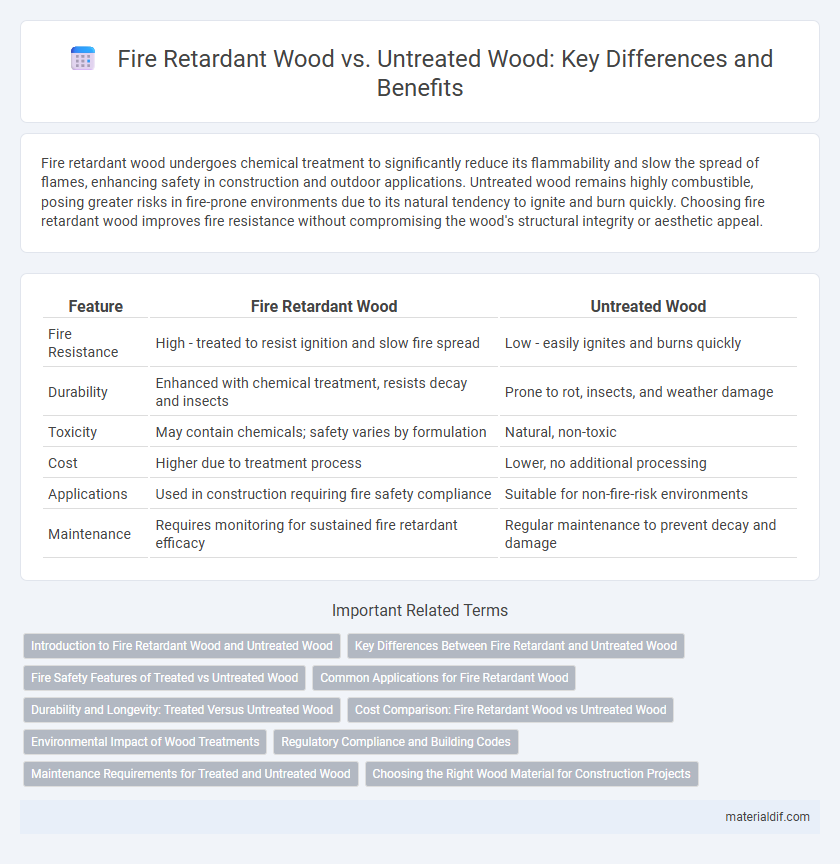Fire retardant wood undergoes chemical treatment to significantly reduce its flammability and slow the spread of flames, enhancing safety in construction and outdoor applications. Untreated wood remains highly combustible, posing greater risks in fire-prone environments due to its natural tendency to ignite and burn quickly. Choosing fire retardant wood improves fire resistance without compromising the wood's structural integrity or aesthetic appeal.
Table of Comparison
| Feature | Fire Retardant Wood | Untreated Wood |
|---|---|---|
| Fire Resistance | High - treated to resist ignition and slow fire spread | Low - easily ignites and burns quickly |
| Durability | Enhanced with chemical treatment, resists decay and insects | Prone to rot, insects, and weather damage |
| Toxicity | May contain chemicals; safety varies by formulation | Natural, non-toxic |
| Cost | Higher due to treatment process | Lower, no additional processing |
| Applications | Used in construction requiring fire safety compliance | Suitable for non-fire-risk environments |
| Maintenance | Requires monitoring for sustained fire retardant efficacy | Regular maintenance to prevent decay and damage |
Introduction to Fire Retardant Wood and Untreated Wood
Fire retardant wood is chemically treated to resist ignition and slow the spread of flames, enhancing safety in construction and reducing fire hazards compared to untreated wood. Untreated wood, naturally combustible, lacks these protective properties, making it more susceptible to fire damage and faster burning rates. Fire retardant treatments often include water-based or intumescent coatings that preserve wood's structural integrity while improving fire resistance.
Key Differences Between Fire Retardant and Untreated Wood
Fire retardant wood is chemically treated to inhibit ignition and slow flame spread, significantly enhancing fire resistance compared to untreated wood. Untreated wood combusts easily and contributes to rapid fire propagation, posing higher safety risks in construction and manufacturing. The durability and safety benefits of fire retardant wood make it a preferential choice in buildings requiring stringent fire codes and enhanced protection.
Fire Safety Features of Treated vs Untreated Wood
Fire retardant wood is chemically treated to slow ignition and reduce flame spread, significantly improving fire safety compared to untreated wood, which burns quickly and intensifies fire hazards. Treated wood achieves higher fire resistance ratings, often meeting strict building codes for fire protection in residential and commercial structures. In contrast, untreated wood lacks these protective properties, leading to faster combustion and increased risk during fire emergencies.
Common Applications for Fire Retardant Wood
Fire retardant wood is commonly used in commercial buildings, schools, and public facilities due to its enhanced resistance to fire, meeting strict building codes and safety standards. It is ideal for structural components, interior paneling, and roofing materials where fire performance is critical. Unlike untreated wood, fire retardant wood helps slow the spread of flames and reduces smoke development, making it essential for evacuation safety and insurance compliance.
Durability and Longevity: Treated Versus Untreated Wood
Fire retardant wood offers significantly enhanced durability and longevity compared to untreated wood, as it resists combustion and slows fire spread, reducing structural damage. Treated wood incorporates chemical additives that help maintain integrity under extreme heat, extending its lifespan in fire-prone environments. Untreated wood lacks these protective properties, making it more vulnerable to fire damage and accelerated degradation over time.
Cost Comparison: Fire Retardant Wood vs Untreated Wood
Fire retardant wood typically costs 20% to 50% more than untreated wood due to the additional chemical treatment processes involved. While untreated wood is initially cheaper, the investment in fire retardant wood can reduce insurance premiums and potential fire damage expenses, offering long-term financial benefits. Cost variations also depend on wood species, treatment type, and regional market prices.
Environmental Impact of Wood Treatments
Fire retardant wood treatments often contain chemical additives such as borates, phosphates, and ammonium compounds that can reduce flammability but may leach into soil and waterways, impacting ecosystems. Untreated wood, while more biodegradable and less chemically intensive, poses higher fire risks but avoids introducing synthetic chemicals into the environment. Choosing fire retardant wood requires balancing enhanced safety with potential ecological effects of chemical leaching and long-term environmental persistence.
Regulatory Compliance and Building Codes
Fire retardant wood meets stringent regulatory compliance and building codes by undergoing chemical treatments that enhance its resistance to ignition and slow flame spread, making it suitable for use in fire-sensitive environments. Untreated wood lacks these protective properties and typically fails to comply with fire safety standards required in commercial and residential construction. Choosing fire retardant wood ensures adherence to fire safety regulations such as ASTM E84 and ICC codes, reducing the risk of fire hazards and facilitating legal project approvals.
Maintenance Requirements for Treated and Untreated Wood
Fire retardant wood requires periodic reapplication of fire-resistant coatings to maintain its protective properties, typically every 3 to 5 years depending on environmental exposure. Untreated wood demands more frequent inspections and treatment against moisture, pests, and weathering to prevent decay and structural damage. Proper maintenance of fire retardant wood can extend its lifespan and enhance safety compared to untreated wood, which is more vulnerable to deterioration without consistent upkeep.
Choosing the Right Wood Material for Construction Projects
Fire retardant wood significantly enhances safety in construction projects by reducing the wood's combustibility and slowing flame spread, making it ideal for buildings requiring stringent fire codes compliance. Untreated wood, while more cost-effective and easier to work with, lacks the protective chemicals that prevent ignition and fire damage, posing higher risks in fire-prone environments. Selecting fire retardant wood supports long-term building integrity and occupant safety, especially in commercial, residential, and public infrastructure where fire resistance is critical.
Fire Retardant Wood vs Untreated Wood Infographic

 materialdif.com
materialdif.com